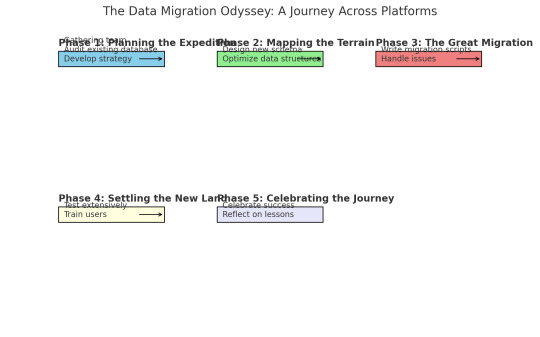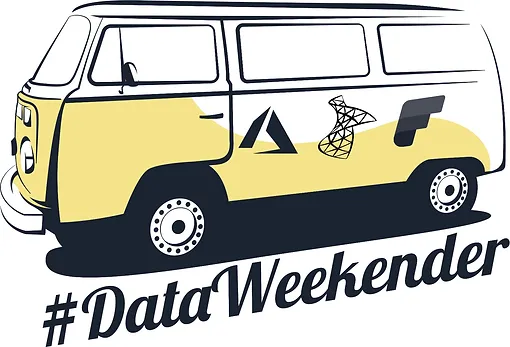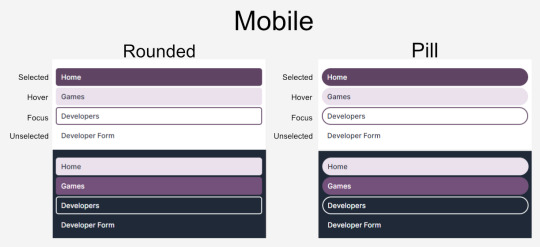#Database Design
Text
The Data Migration Odyssey: A Journey Across Platforms

As a database engineer, I thought I'd seen it all—until our company decided to migrate our entire database system to a new platform. What followed was an epic adventure filled with unexpected challenges, learning experiences, and a dash of heroism.
It all started on a typical Monday morning when my boss, the same stern woman with a flair for the dramatic, called me into her office. "Rookie," she began (despite my years of experience, the nickname had stuck), "we're moving to a new database platform. I need you to lead the migration."
I blinked. Migrating a database wasn't just about copying data from one place to another; it was like moving an entire city across the ocean. But I was ready for the challenge.
Phase 1: Planning the Expedition
First, I gathered my team and we started planning. We needed to understand the differences between the old and new systems, identify potential pitfalls, and develop a detailed migration strategy. It was like preparing for an expedition into uncharted territory.
We started by conducting a thorough audit of our existing database. This involved cataloging all tables, relationships, stored procedures, and triggers. We also reviewed performance metrics to identify any existing bottlenecks that could be addressed during the migration.
Phase 2: Mapping the Terrain
Next, we designed the new database design schema using schema builder online from dynobird. This was more than a simple translation; we took the opportunity to optimize our data structures and improve performance. It was like drafting a new map for our city, making sure every street and building was perfectly placed.
For example, our old database had a massive "orders" table that was a frequent source of slow queries. In the new schema, we split this table into more manageable segments, each optimized for specific types of queries.
Phase 3: The Great Migration
With our map in hand, it was time to start the migration. We wrote scripts to transfer data in batches, ensuring that we could monitor progress and handle any issues that arose. This step felt like loading up our ships and setting sail.
Of course, no epic journey is without its storms. We encountered data inconsistencies, unexpected compatibility issues, and performance hiccups. One particularly memorable moment was when we discovered a legacy system that had been quietly duplicating records for years. Fixing that felt like battling a sea monster, but we prevailed.
Phase 4: Settling the New Land
Once the data was successfully transferred, we focused on testing. We ran extensive queries, stress tests, and performance benchmarks to ensure everything was running smoothly. This was our version of exploring the new land and making sure it was fit for habitation.
We also trained our users on the new system, helping them adapt to the changes and take full advantage of the new features. Seeing their excitement and relief was like watching settlers build their new homes.
Phase 5: Celebrating the Journey
After weeks of hard work, the migration was complete. The new database was faster, more reliable, and easier to maintain. My boss, who had been closely following our progress, finally cracked a smile. "Excellent job, rookie," she said. "You've done it again."
To celebrate, she took the team out for a well-deserved dinner. As we clinked our glasses, I felt a deep sense of accomplishment. We had navigated a complex migration, overcome countless challenges, and emerged victorious.
Lessons Learned
Looking back, I realized that successful data migration requires careful planning, a deep understanding of both the old and new systems, and a willingness to tackle unexpected challenges head-on. It's a journey that tests your skills and resilience, but the rewards are well worth it.
So, if you ever find yourself leading a database migration, remember: plan meticulously, adapt to the challenges, and trust in your team's expertise. And don't forget to celebrate your successes along the way. You've earned it!
6 notes
·
View notes
Text
I'm Speaking at DataWeekender 6.5!
Unfortunately, the Data TLV summit was delayed. But I still have some good news: I'll be speaking at #DataWeekender 6.5 on November 11, and I will be delivering a brand new session! ✨
It's next week! Register now!
#Microsoft #SQLServer #MadeiraData
Unfortunately, the Data TLV summit was delayed. But I still have some good news: I’ll be speaking at #DataWeekender 6.5 on November 11, and I will be delivering a brand new session! ✨
Continue reading Untitled

View On WordPress
0 notes
Text
The Importance of Data Modeling Standards in Software Engineering

Introduction to Data Modeling
Data modeling is a crucial process in the world of information technology and database management. It involves creating a visual representation of how data is structured, organized, and related within a database system. The goal of data modeling is to ensure that data is accurately and efficiently stored, accessed, and manipulated.
In this blog, you will get a comprehensive overview of the significance and various types of data modeling standards.
Importance of Modeling Standards
Data modeling standards are vital for organizations aiming to establish a robust foundation for efficient data management for a business.
Here are a few pointers explaining the importance of modeling standards:
Consistency: Data modeling standards ensure the representation of data across different systems. Due to such a consistent practice, it promotes clarity and reduces confusion.
Interoperability: Standards enable seamless integration and communication between diverse data systems. This facilitates data sharing and collaboration.
Data Quality: By enforcing standardized modeling practices, data modeling standards enhance:
data accuracy
data completeness
data integrity
Re-usability: Standardized data models can be reused across projects and organizations. This helps to save a lot of time and effort in designing new models from scratch.
Maintenance and Scalability: It simplifies the maintenance of tasks by providing a structured approach to managing data models. This in turn makes it easier to update and modify as systems evolve.
Governance and Compliance: Data modeling standards help ensure:
Regulatory compliance
Data governance
Security
These are essential for safeguarding data privacy and protection.
Cost Efficiency: Implementing standardized data models reduces development and maintenance costs by:
Streamlining processes
Enhancing productivity
Avoiding inconsistencies
Types of Modeling Standards
There are various types of modeling standards that data modelers can adopt, depending on their specific needs and industry requirements.
Here are a few commonly used ones:
Entity-Relationship (ER) Modeling Standards: These modeling standards focus on the representation of entities, attributes, and relationships within a database. They define guidelines for:
entity naming
attribute data types
relationship cardinality
notation conventions
Database Design Standards: These provide guidelines for creating and structuring databases. They cover aspects such as:
table naming conventions
primary key and foreign key definitions
data type usage
normalization techniques
Adhering to these standards ensures that databases are designed with appropriate indexing and relationships between tables.
Data Integration Standards: These standards focus on integrating data from multiple sources into a unified database. They define rules for data mapping, transformation, and consolidation. These enable seamless data exchange between different systems.
Metadata Standards: Metadata standards enhance data governance by providing a comprehensive understanding of data semantics and lineage.
These establish guidelines for:
- Metadata representation
- Naming conventions
- Documentation
In the realm of data modeling, adherence to modeling standards is of utmost importance. To avoid data breaches, errors, and non-compliance risks, adopting appropriate modeling standards is the best option. This will provide effective data governance and protection for your business.
Also, check how you can secure your business with Nitor Infotech with top-notch innovative solutions.
#data modeling tools#nitorinfotech#blog#data modeling#business intelligence#machine learning#metadata#data quality management#database design#scalability#data governance
1 note
·
View note
Text
Best Practices for MySQL Database Optimization
New Post has been published on https://www.codesolutionstuff.com/best-practices-for-mysql-database-optimization/
Best Practices for MySQL Database Optimization
MySQL is one of the most popular open-source relational databases used by businesses and individuals around the world. As your database grows, it can become slower and less responsive, which can negatively impact your application's performance. In this blog post, we'll explore techniques and
#Buffering#Data Management#Database Administration#Database Design#Database Optimization#Indexing#Normalization#Open-Source Databases#Query Analysis#Query Optimization#Query Performance#Relational Databases#Server Configuration#SQL Commands#SQL Joins
0 notes
Text
Top 25 Job Interview Questions for Software developer
Here are the Top 25 Job Interview Questions for Software developer
Can you tell us about your experience with [specific programming language or technology]?
How do you approach problem-solving when coding?
Can you walk us through the development process for a project you recently worked on?
Can you explain a technical concept to someone non-technical?
Have you ever collaborated with a team on a…

View On WordPress
#automated testing#code quality#code reviews#continuous integration and deployment#database design#deadlines#debugging#debugging in production environment#development process#fixing bugs#incorporating feedback#integrating technology#performance optimization#problem-solving#programming language#responsive vs adaptive design#security measures#staying up-to-date#task prioritization#teamwork#technical concept#technical decision#version control
0 notes
Text
#misc polls#I tried to avoid animals that already exist or could easily be made with existing bases#like no owls bc blathers and celeste#no donkeys bc we already have horses#I know tortimer is a tortoise but think of the potential a shell has for designs#plus tortimer is very old I think a villager turtle would look substantially different#and lyle is an otter not a weasel#I also had long haired cat pointy eared dog and floppy eared rabbit on here but replaced them with more unique animals#had to really comb through littelest pet shop databases to think of some of these lmao
477 notes
·
View notes
Text
Ryan Yip explains what a fabulous resource for sewers of all kinds the Royal School of Needlework Stitch Bank is.
#sewing#embroidery#stitches#database#needlework#textiles#fashion#fashion history#costume design#costume history#couture#ryan yip#tiktok#sewing resources#dressmaking#embellishment#decorative#video
93 notes
·
View notes
Text
153 notes
·
View notes
Text

what if i gave megatron a newspark..
they like music and would like to become a medic one day, like ratchet !!
#transformers#megatron#sunlight#au#art#i like the mentors concept of idw2 so im stealing it#so basically a cybertronian has to sign up to vector sigma's database or something like that and agree to take care of a sparkling#and it will let the mech know. after some time has passed (can be maybe 10 years or up to a millennia) when its time to pick up their child#so they have to go to the designated hot spot and get the kid to successfully emerge from the dirt and take em home#the mentor has to teach their apprentice about life and spending money wisely. help em choose their alt mode.. the basics#sunlight transforms into foc bumblebee's alt mode but with a big window at the front. and instead of being yellow#they're light blue or something different LOL#<- i'm still figuring out what their color palette will be so that is subject to change. but they won't be yellow
296 notes
·
View notes
Text
🖇️✒️crafts & doodles!
- 👑a cool crown thing from writing camp to some mind lyrics (ft daph and zebra)
- 🧣rainworld legacy modcats while playing with colors one morning in a seaside hotel—such a vibe!
- 🐦⬛monstrousmedical!mind doodles for scoping out his outfit and style
- 🩺medical!whole recovering from the ordeal (style partially inspired by @if-you-soul’s design of soul :])





#chonny jash#cccc#contemptual counterpart conciousness clinic#medical!hms#medical!mind#monstrousmedical!mind#medical!whole#cj hms#song lyrics#mind chonny jash#chonny jash mind#cj mind#rainworld#rain world#rainworld modding#rainworld modcats#rw legacy modcats#raindb#rainworld modding database#traditional art#traditional sketch#character design#character concept#playingwithpens&pencils#rainworld downpour#rain world downpour#my favourite idiots#medical concepts#creativecorner#pathetic idiots
9 notes
·
View notes
Text
The months of the year in order according to our database program
January, October, November, December, February, March, April, May, June, July, August, September
7 notes
·
View notes
Text



(Art by @chaotic-minds-think-alike )
. . .
They become loud sometimes.
#wow more hurting eight lol#also his cyborg/human-ish/gjinka design lol#and his void lizards#ES#creature database
140 notes
·
View notes
Text
Help choose the Navigation button style for the Amare Games Database!


I've been revamping some of the visual elements of the website and making sure everything is WCAG compliant for web accessibility.
While doing that I thought it would be fun to do a poll to see which style of buttons folks like better for the website.
I've added some images of what the 2 options look like in both dark and light mode.
So do you prefer rounded corners of pill-style buttons?
* Also I'm not sure why but Tumblr decided to destroy the image quality of the examples. But you folks get the idea.
9 notes
·
View notes
Text
I wish tumblr polls had a built-in "see results" button that didn't influence the poll in any way, maybe even prevent you from voting if you choose it so you can't be influenced by the results. so many polls get drowned out by the "this doesn't apply to me but i want to see the results" option that they're bordering on useless, having an extra option at the bottom of the poll would be a gamechanger for that.
also let us choose if people can select multiple options to get rid of the "more than one" choice that every poll has, that also clogs things up. @staff make me ceo and i will fix polls for you.
#obviously tumblr polls aren't That Serious but like#so many polls have See Results as the overwhelming winner and it makes it that much harder to actually interpret the results#like. cool 40% of the people who voted didn't actually choose an answer this is really great data 👍#@staff @humans please hire me i have a basic grasp on web design and database management and this is the only change i'll make before i qui
14 notes
·
View notes
Text



never underestimate the power of a metadata specialist & a database
#designing the notion database was the most enjoyable#i still have a handful of albums and a bunch of pcs to inventory#i don't consider myself a hardcore collector or anything (...except for besties <3 and star seekers) so my collection is not That big#however i felt like i easily lost track of things (especially when concert dvds or similar are on order for months)#soooo hopefully this will be helpful#and not difficult to maintain once i actually. get everything in there#wings.collects
11 notes
·
View notes
Text

art piece number one, say hi to my version of @shady-item-shop
18 notes
·
View notes